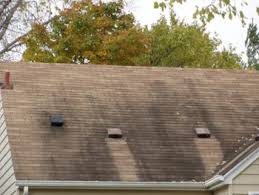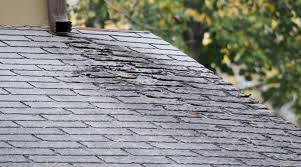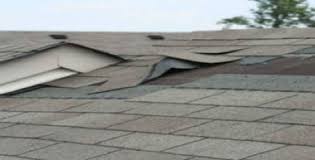How do you know when it is time to replace your roof?
As a homeowner, maintaining your property and ensuring it remains up to code at all times is one of your most important responsibilities. Similar to most investments in life, homes require maintenance and upkeep as years pass to provide maximum comfort, safety, and security.
The longer you have lived in your home, the more likely you have considered investing in a new roof to replace your old roof. Before moving forward with the decision to replace your roof entirely, there are a few signs to watch for to determine whether or not the time is right for you and your home.
Curled or Buckled Shingles
Curled or Buckled shingles are a clear sign that your roof has some age on it. Buckled shingles can occur because of moisture in the attic space forcing nails to push up and out of the roof’s decking. This mishap can leave your home exposed to outside elements as well as being prone to shingle blow-offs during a storm.
Tar Streaking or Algae Growth
Tar Streaking and Algae growth is caused by bacteria eating away at the shingles weatherproofing properties. Cheap shingle manufacturing companies use fillers like limestone to keep the cost of shingle production low. This algae will eat away the limestone causing the black streaking and thus compromising the weatherproofing properties.

Shingles Blown Off the Roof
It this is happening, it means that the shingles have dried, curled, and cracked. Obviously, if the shingles are in your yard then they aren’t on your roof! So when you start to see this it is time to get that roof replaced.
Missing Granules
Missing granules, when viewed from the ground, look like dark patches on light shingles or lighter patches if the shingles are black or dark. You will also see large amounts of granules in the gutters when you clean them.
The loss of granules do not affect the waterproofing of the roof, so if they are missing you won’t necessarily get leaks. But the granules protect the asphalt in the shingle from being damaged by the UV rays of the sun. So once they go, the shingles will wear out faster.

Flashing
Flashing is common in chimneys, vents, and even skylights and can help with sealing various seams to protect your home from any type of weather. When you are inspecting your home’s roof, be sure to check all potential flashing areas of your home to determine whether or not the areas are leaking or have cracks in them.
Flashing beams of light can signify a more serious issue that requires immediate attention.
It is also important to note that many old homes typically use a cement flashing system, which is considered outdated today. If you are thinking of updating your flashing system, consider an all-in-one metal solution for longevity and durability.
Streaks and Discoloration
Whenever you are inspecting the interior or exterior of your roof it is important to look for discoloration and off-colored streaks on your roof that simply does not belong. Streaks and discoloration are some of the telltale signs that a roof requires attention, even if it does not require a complete renovation or replacement.
Take note of streaks and discoloration you discover while inspecting your roof. If possible, take photos and be sure to note the approximate location of each of the streaks or discolored beams you have discovered. While some streaks and discoloration just may require a bit of attention, others may be a sign of a deeper underlying issue.
Lack of a Chimney Cricket
If you currently own an older home with a large chimney, be sure to verify that your chimney has a “chimney cricket” installed. A chimney cricket is a solution that acts as an additional roof for a home’s chimney. As the seasons pass and weather changes, chimneys collect debris, dirt, and water buildup. Without a chimney cricket in place, you run the risk of furthering issues in your home from leakage, water damage, and even from nature outdoors. Ensuring your home’s chimney has a chimney cricket in place can significantly reduce the risk of encountering issues with your home’s roof system and your chimney.

Replace your roof if the shingles are in bad shape
The easiest way to tell that you need to replace your roof is that the shingles themselves are starting to look worn. There are a few ways to tell that you will need a new roof based on how your shingles look:
- The edges of the shingles may be curled or have a cup-like appearance
- The shingles are cracking
- There may be bald patches
In short, if your roof is starting to look old and worn out, it’s time for a new one.
Moss is appearing
Another key sign that you may need to replace your roof is that you’re seeing moss on or between the shingles. While it might seem like moss on the roof is a quaint quality that will make your home look like a fairy tale cabin in the woods, it’s a sign of a potential problem.
Moss itself is not an automatic sign that you need a new roof immediately. Moss does naturally grow on or between shingles, especially on roofs that are in shaded or moist climates. But moss could hint at hidden damage.
The problem with moss is that when it rains, the moss absorbs the water like a sponge and holds onto it. The whole point of shingles is to allow water to roll off the roof and into the gutters. When moss is present, it keeps that moisture from going where it’s meant to go. That can lead to the shingles themselves breaking down. Since moss impedes the water from reaching the gutters, it can also lead to that water seeping into the layers under the shingles, causing water damage and mold growth.
So if you see moss, you’ll need to call a roofing contractor to clean up the moss and look for signs of permanent damage.
Consider the age of the roof
Another key factor in determining if you need to replace your roof is the age of that roof. This isn’t a warning sign you can see at times, but it’s worth keeping in mind. Roofs that are at least 20 years old may benefit from replacement with higher quality materials. Typical asphalt shingles last about that long.
Other materials may last longer, however. Slate, copper and clay/concrete roofs can last over 50 years and wood shake roofs can last around 30, for instance. So, depending on what material you have on your roof and the last time it was replaced, it could just be time so that you avoid leaks down the road.
And, remember, for an investment this large, you might want to consider getting materials that will last longer and be more durable, like metal roofing. This is one of those home purchases where a higher up-front cost could mean fewer repairs down the road. It could be a good investment, especially for a home you plan to stay in as long as possible. If you plan correctly, you might not have to replace your roof ever again.
Excessively High Energy Bills
High heating and cooling bills can be from energy escaping due to poor ventilation and insulation in your home, especially in your attic and roof. If you notice you have high energy bills in addition to any of the warning signs listed above, it could be because your roof is under-performing.
A common misconception is that a roof is good for 10-15 years. A new roof should last at least that long, however, if there is mis-application or sub-par materials, the age means absolutely nothing. Use these tips to help protect your home and family and make sure that your roofing system is protecting your home for a lifetime.